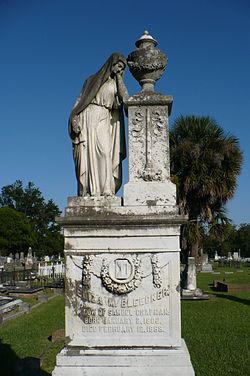Magnolia Cemetery (Mobile, Alabama)
|
Magnolia Cemetery including Mobile National Cemetery
|
|

Neoclassical-style statuary monument for Eliza Bleecker.
|
|
| Location | Ann and Virginia Streets, Mobile, Alabama |
|---|---|
| Coordinates | 30°40′27.00″N 88°3′50.11″W / 30.6741667°N 88.0639194°WCoordinates: 30°40′27.00″N 88°3′50.11″W / 30.6741667°N 88.0639194°W |
| Built | 1836 |
| Architectural style | Funerary |
| NRHP Reference # | 86003757 |
| Added to NRHP | June 13, 1986 |
Magnolia Cemetery is a historic city cemetery located in Mobile, Alabama. Filled with many elaborate Victorian-era monuments, it spans more than 100 acres (40 ha). It served as Mobile's primary, and almost exclusive, burial place during the 19th century. It is the final resting place for many of Mobile's 19th and early 20th century citizens. The cemetery is roughly bounded by Frye Street to the north, Gayle Street to the east, and Ann Street to the west. Virginia Street originally formed the southern border before the cemetery was expanded and now cuts east–west through the center of the cemetery. Magnolia contains more than 80,000 burials and remains an active, though very limited, burial site today.
Magnolia Cemetery was established by municipal ordinance on an initial 36 acres (15 ha) parcel outside the city limits in 1836 as Mobile's New Burial Ground. The cemetery grew to its present size with the addition of the numerous new sections.
The Jewish Rest section, also known as the Old Hebrew Burial Ground, was deeded to Congregation Sha'arai Shomayim, the oldest Reform Jewish congregation in the state of Alabama, by the City of Mobile on June 22, 1841. Jewish Rest is the oldest Jewish burial ground in Alabama. The Jewish Rest section was full after only a few decades and led to the establishment of two additional Jewish cemeteries in Mobile, the Sha'arai Shomayim Cemetery for the Reform congregation and the Ahavas Chesed Cemetery for the Conservative congregation.
In 1846 the city began to grant free burial plots within the cemetery to civic, labor, and religious organizations. The Coal Handlers Union, Colored Benevolent Institution Number One, Cotton Weighers Society, Draymens Relief Society, Homeless Seamen, Independent Ladies Mill and Timber Association, and the Protestant Orphan Asylum Society were among those organizations to take advantage of this policy until it was ended in 1873.
The Confederate Rest section was added on November 25, 1861 for Confederate soldiers. It was initially called Soldiers Rest. The Mobile National Cemetery annex was established immediately after the war, on May 11, 1866, when the city donated 3 acres (1.2 ha) to the United States government for use as a National Cemetery. The cemetery as a whole was renamed Magnolia Cemetery on January 15, 1867.
...
Wikipedia
